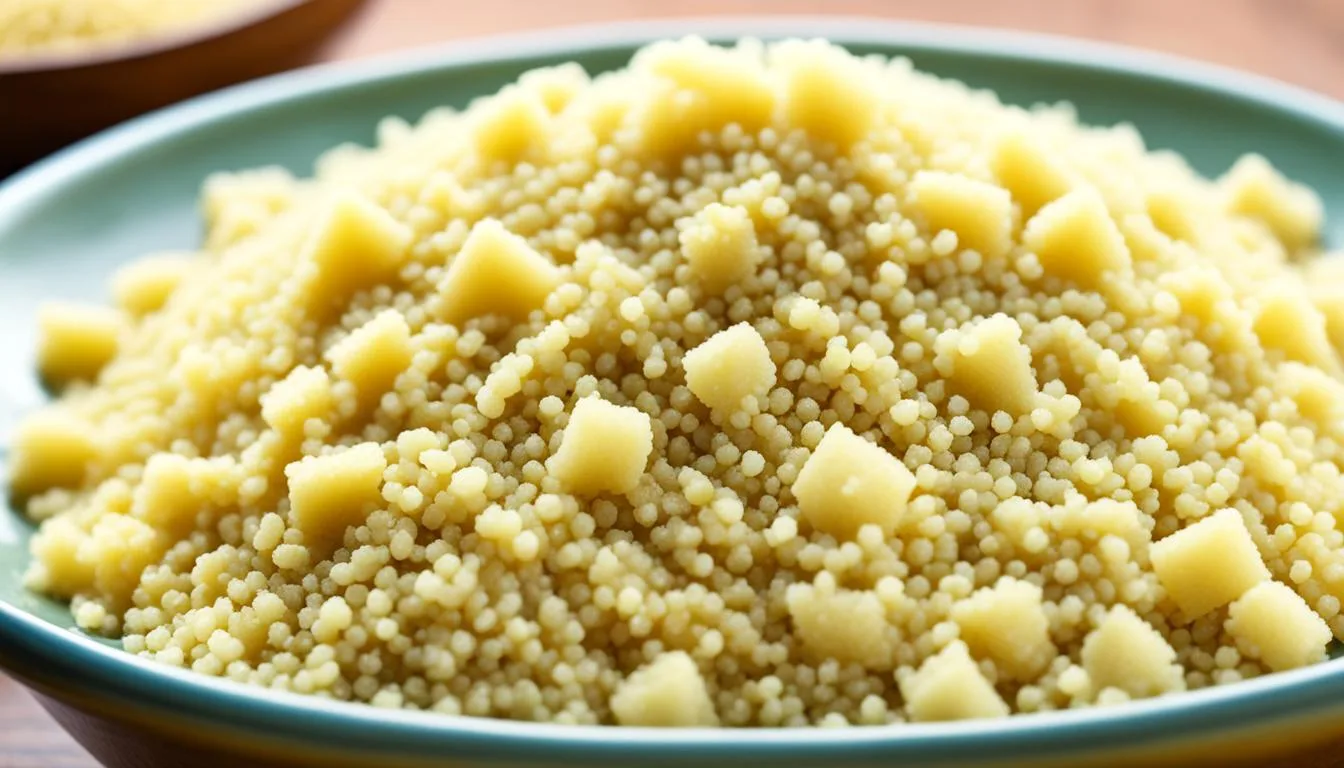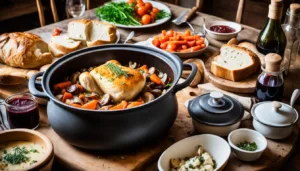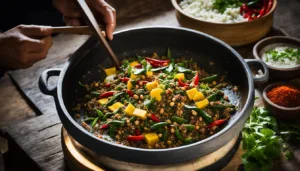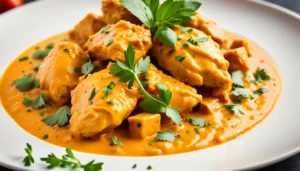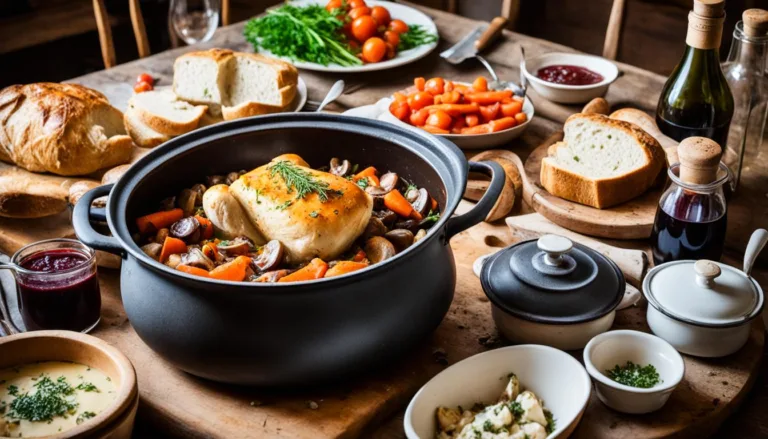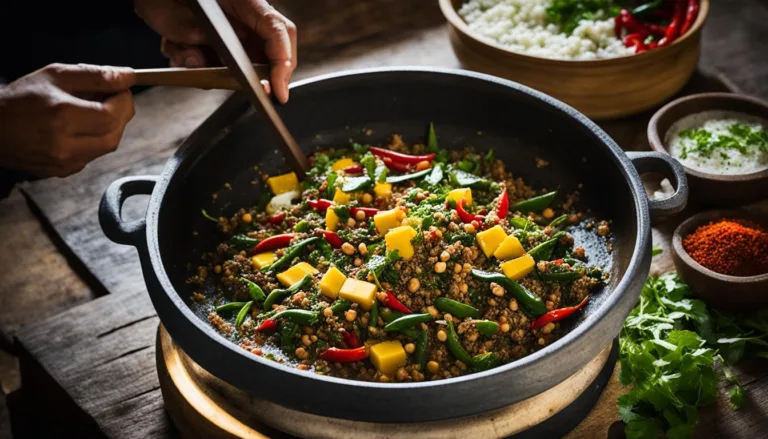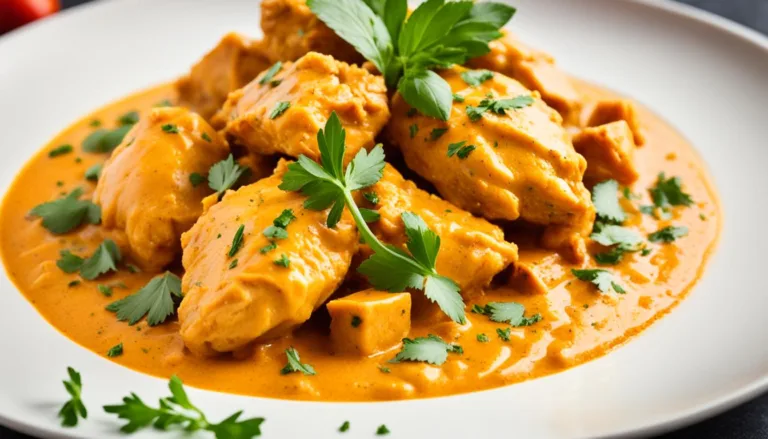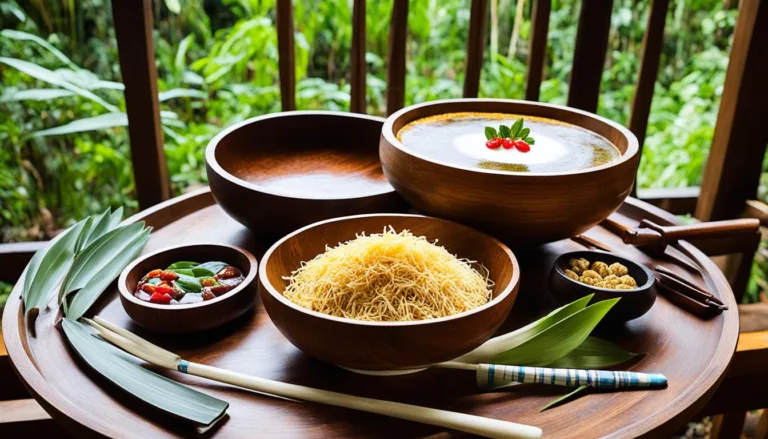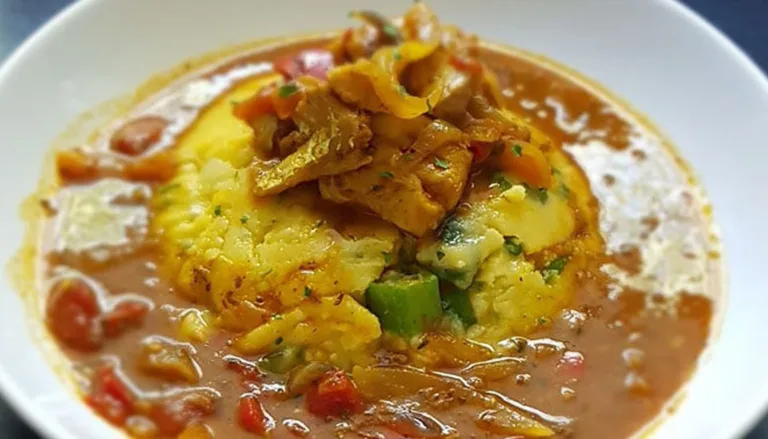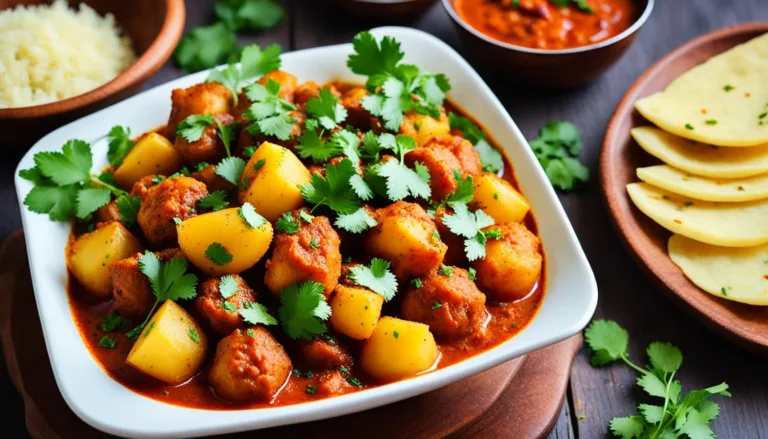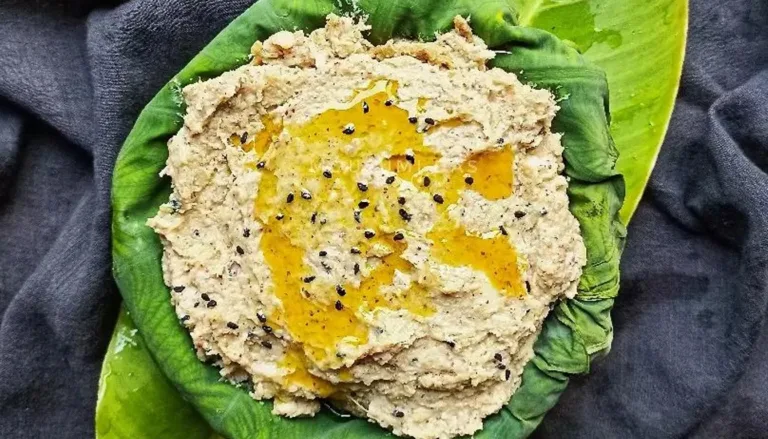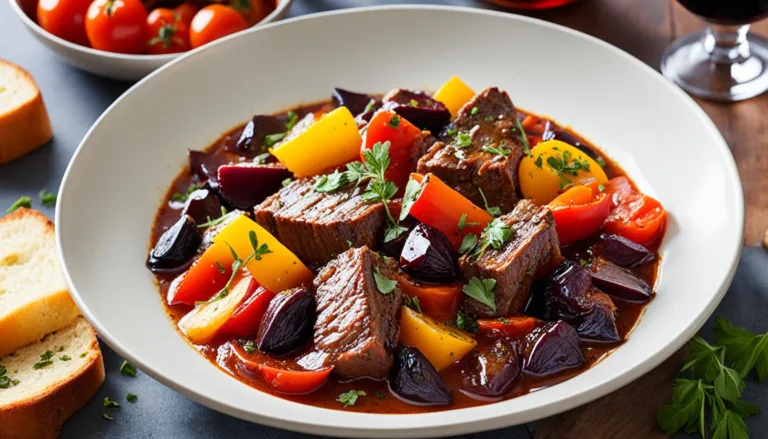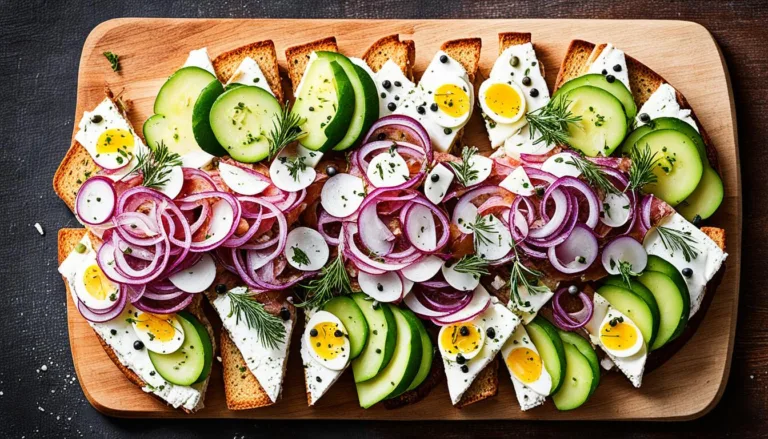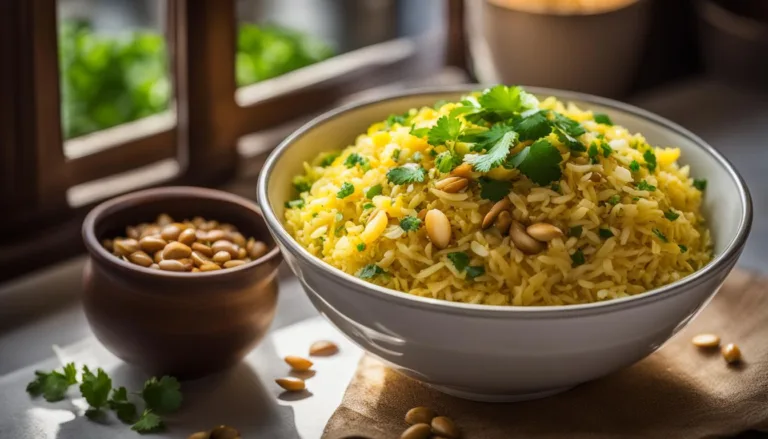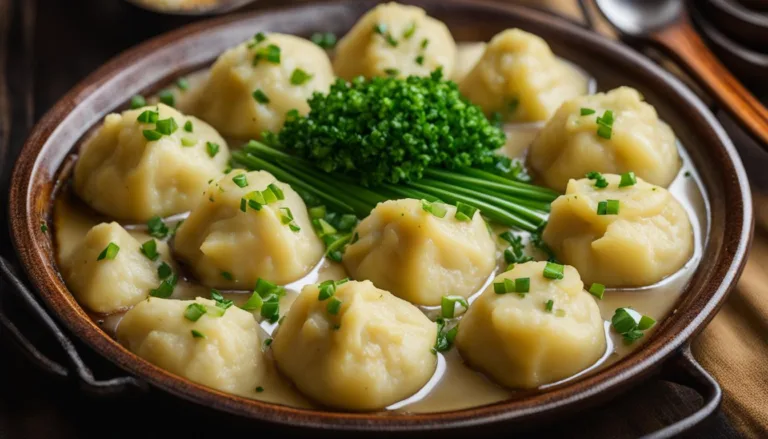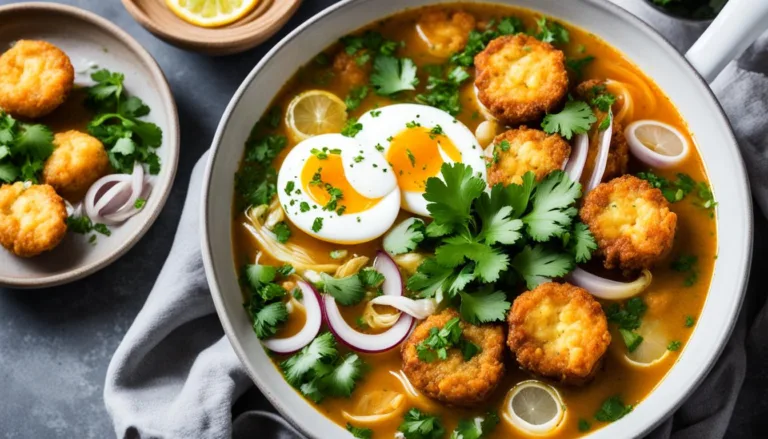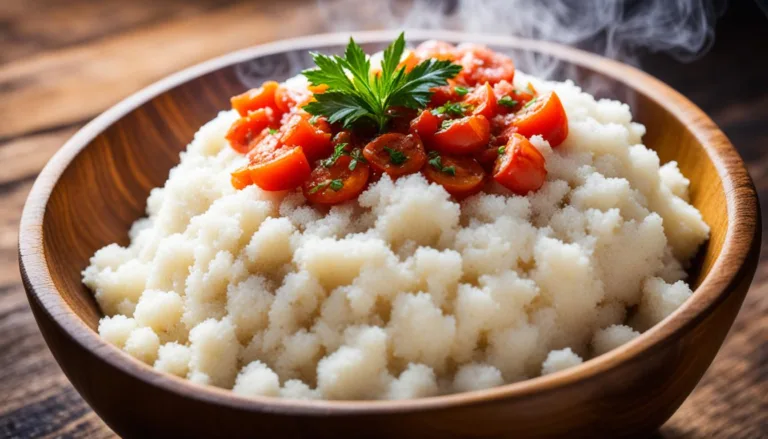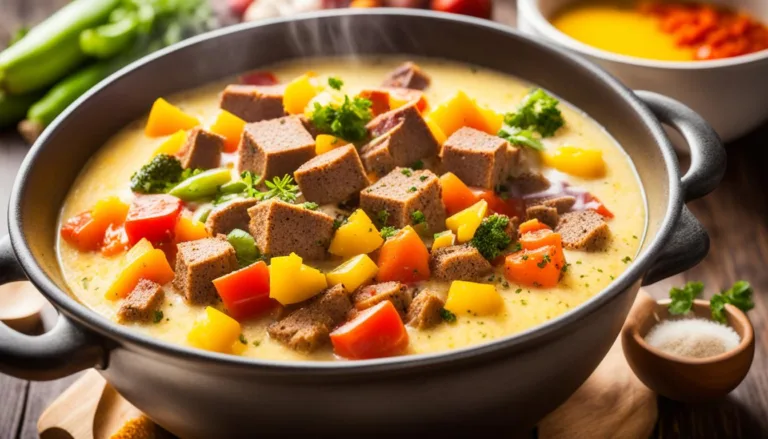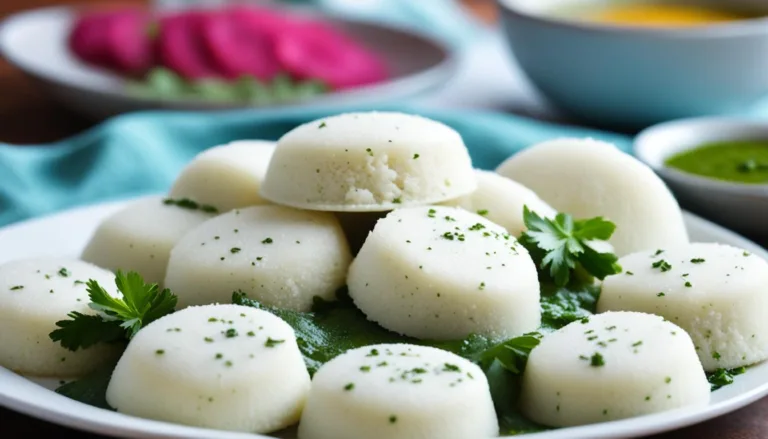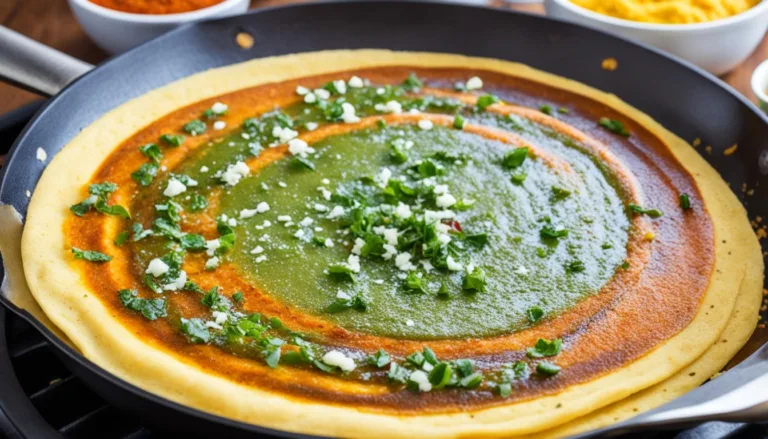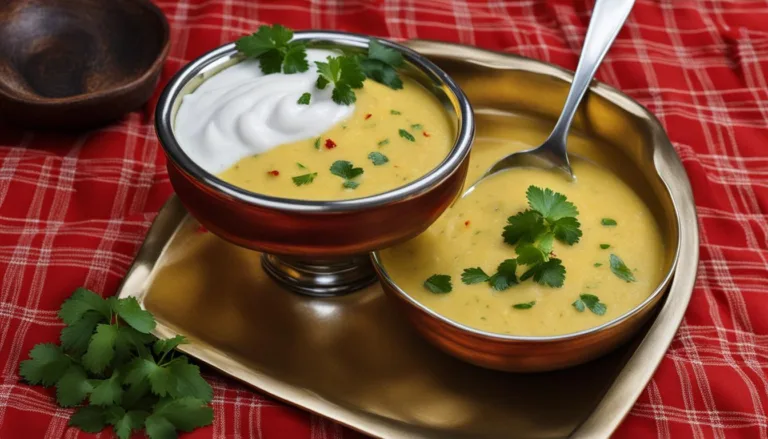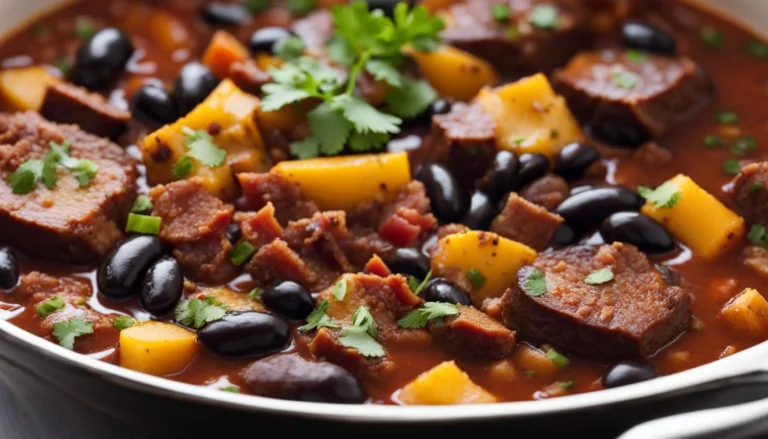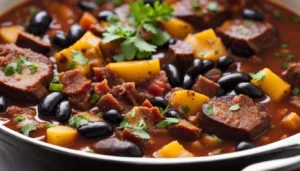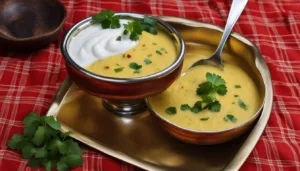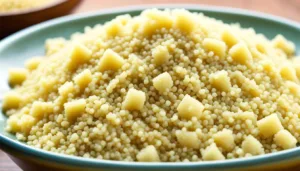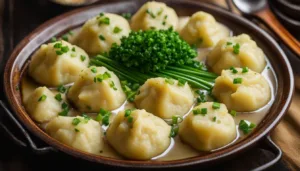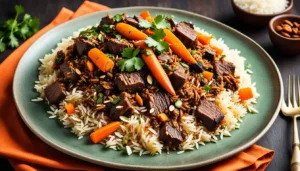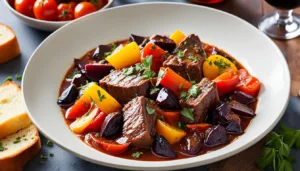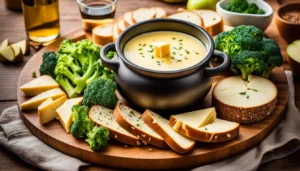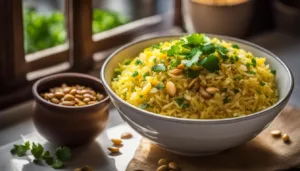Welcome to our blog! Are you in search of an easy couscous recipe that yields perfect fluffy results every time? Look no further! We’ve got you covered with a recipe that is simple to follow and guarantees delicious couscous. Whether you’re a beginner or an experienced cook, you can create light, fluffy, and flavorful couscous with our step-by-step guide and helpful tips. Let’s get started!
Table of Contents
Key Takeaways:
- Our easy couscous recipe delivers perfect fluffy results every time.
- Whether you’re a beginner or an experienced cook, this recipe is simple to follow.
- Our step-by-step guide and helpful tips ensure light, fluffy, and flavorful couscous.
- Prepare for success by understanding the basics of couscous cooking.
- Elevate the flavor of your couscous with various herbs, spices, and add-ins.
Discovering the World of Couscous
In this section, we will explore the fascinating world of couscous. Couscous is a staple dish that has a rich history and cultural significance. Let’s dive into the origins of couscous and its journey from North Africa to cuisines around the globe.

Couscous, believed to have originated in North Africa, has been a culinary tradition for centuries. It holds a special place in the hearts and palates of people across the region. Over time, its popularity spread to different parts of the world, contributing to the diverse culinary landscape we experience today.
There are various types of couscous, each with its own unique characteristics and cooking methods. Let’s explore some of them:
- Moroccan couscous: This is the most common type of couscous, known for its fine and fluffy texture. It is typically steamed to perfection and pairs well with a variety of dishes.
- Pearl couscous: Also known as Israeli couscous, this type is larger in size and has a slightly chewy texture. It is often toasted before cooking, adding a delicious nutty flavor to the dish.
- Lebanese couscous: This couscous variety is larger than Moroccan couscous and has a more robust texture. It takes longer to cook but offers a heartier bite, making it ideal for salads and stews.
Now let’s discover the culinary uses of couscous. Couscous is incredibly versatile and can be incorporated into a wide range of dishes. Whether as a side dish or the star of the meal, couscous lends itself well to various cuisines and flavors. It can be served alongside grilled meats, roasted vegetables, or used as a base for salads and grain bowls.
From classic Moroccan tagines to Mediterranean-inspired salads, couscous brings a delightful complexity and texture to dishes. It absorbs flavors beautifully, making it a perfect canvas for experimenting with different spices, herbs, and ingredients.
Now that we have delved into the world of couscous, let’s move on to the next section, where we will guide you in choosing the right type of couscous for your dish.
Choosing the Right Type of Couscous for Your Dish
In this section, we will discuss the different types of couscous and help you choose the right one for your dish. Couscous is a versatile grain that comes in various forms, each with its own unique characteristics and cooking times. By understanding the flavor profiles and cooking properties of different types of couscous, you can enhance the taste and texture of your recipes. Let’s explore three popular types of couscous:
Moroccan Couscous: Quick Cooking Delight
Moroccan couscous is the most common and widely available type. It has a fine texture and is made from semolina wheat. This variety of couscous cooks quickly, usually within 5 minutes, making it ideal for busy weeknight meals. Moroccan couscous has a light and fluffy consistency, making it perfect for absorbing flavors and sauces. It pairs well with a wide range of ingredients, and its delicate texture allows it to complement both light and heavy dishes.
Pearl Couscous: A Toasted Treasure
Pearl couscous, also known as Israeli couscous, is made from wheat flour and rolled into small granules. Unlike Moroccan couscous, pearl couscous has a toasted flavor and a slightly larger size. It has a chewy texture that adds a pleasant bite to any dish. Pearl couscous requires a slightly longer cooking time, usually around 10-12 minutes. The toasted flavor of pearl couscous makes it a great option for salads, pilafs, and hearty side dishes.
Lebanese Couscous: The Hearty Option
Lebanese couscous, also known as Moghrabieh, is a larger and heartier variety. The grains are often described as tiny balls, similar to small pearls. Lebanese couscous has a nutty flavor and a more substantial texture. It takes a bit longer to cook compared to other types of couscous, typically around 15-20 minutes. This robust couscous is perfect for stews, casseroles, and dishes where you want a satisfying bite. Its larger size also makes it an excellent choice for stuffing and filling.
To help you visualize the differences between the types of couscous, here is a handy table:
| Type of Couscous | Texture | Cooking Time | Flavor Profile |
|---|---|---|---|
| Moroccan Couscous | Fine and fluffy | 5 minutes | Delicate and versatile |
| Pearl Couscous | Toasted and chewy | 10-12 minutes | Nutty and robust |
| Lebanese Couscous | Larger and hearty | 15-20 minutes | Nutty and substantial |
By considering the cooking times, flavor profiles, and textures of different types of couscous, you can enhance your culinary creations and create dishes that are tailored to your preferences. Whether you’re looking for a quick and light couscous or a heartier option, there is a type of couscous to suit every taste and meal. So, choose wisely and enjoy the wonderful world of couscous!

The Couscous Ratio: Understanding Basics
In this section, we will cover the basics of the couscous ratio. Achieving perfectly cooked couscous every time requires an understanding of the proper couscous to water ratio. It’s a simple but crucial step in ensuring that your couscous turns out fluffy and delicious.
When it comes to cooking couscous, the recommended ratio is typically 1 part couscous to 1.5 parts water. This ratio will yield light and fluffy couscous that isn’t too dry or mushy. However, it’s important to note that the specific ratio may vary slightly depending on the type of couscous you’re using and your desired texture.
Here are a few tips and tricks to keep in mind when cooking couscous:
- Use flavorful liquids: Instead of using plain water, consider using broth or stock to cook your couscous. This adds extra depth of flavor to the dish.
- Adjust cooking time: The cooking time can vary depending on how tender or al dente you prefer your couscous. Follow the package instructions as a general guide and adjust the cooking time to achieve your desired texture.
- Fluff with a fork: After the couscous is cooked, fluff it with a fork to separate the grains. This helps prevent clumping and ensures a light and airy texture.
By understanding the basics of the couscous ratio and following these tips, you’ll be able to create perfectly cooked couscous every time. Experiment with different flavors and textures to find your favorite combination.
Perfect Fluffy Couscous: Tips and Techniques
In this section, we will share tips and techniques to help you achieve perfect fluffy couscous. Achieving the perfect texture is crucial for a delicious couscous dish, so we’ll guide you through the process and provide expert advice.
Preparation: Setting the Stage for Success
Before cooking your couscous, it’s important to properly prepare and set the stage for success. Here are a few key tips:
- Measure your ingredients accurately to maintain the right couscous to water ratio. This will ensure that your couscous cooks evenly and achieves a fluffy texture.
- Fluff the couscous grains before cooking. This helps to separate and loosen any clumps, resulting in a lighter and fluffier end product.
- Consider toasting the couscous lightly before cooking. This can enhance the nutty flavor and add an extra dimension of taste to your dish.
- Classic Coq au Vin Recipe – French Comfort Food

- Authentic Ema Datshi Recipe | Taste of Bhutan

- Creamy Chicken Butter Masala Recipe – Taste the special and the best!

Steaming vs. Boiling: Best Methods for Couscous
When it comes to cooking couscous, there are two main methods: steaming and boiling. Both methods have their advantages, so let’s take a look:
Steaming: Steaming couscous allows the grains to absorb the liquid gradually, resulting in a light and fluffy texture. It’s a traditional method used in Moroccan cuisine and requires a couscous steamer or a heatproof colander placed over a pot of simmering liquid.
Boiling: Boiling couscous is a quicker method and works well if you’re short on time. Simply bring the liquid to a boil, add the couscous, and cook until tender. This method is more common for larger types of couscous, such as Moroccan and Lebanese.
The Fluff Factor: Achieving the Perfect Texture
Now, let’s dive into the “fluff factor” – the key to achieving the perfect texture in your couscous. Here’s what you need to know:
- Fluffing with a fork: After cooking the couscous, use a fork to fluff the grains gently. This will separate any clumps and create light, airy couscous.
- Add moisture if needed: If your couscous turns out too dry, you can add a little bit of warm liquid or olive oil and fluff again. This will help to restore moisture and prevent a dry texture.
- Resting time: After fluffing, let the couscous rest for a few minutes. This allows the grains to absorb any remaining moisture and further enhances the texture.
By following these tips and techniques, you’ll be well on your way to achieving the perfect fluffy couscous every time.

Couscous recipe
The Simple Ingredients You’ll Need
To make this easy couscous recipe, you’ll only need a few simple ingredients:
- Couscous
- Liquid (water, broth, or stock)
- Seasonings (salt, pepper, herbs, spices)
Step-by-Step Cooking Instructions
- In a saucepan, bring the liquid to a boil. The amount of liquid you’ll need depends on the specific couscous brand you’re using, so refer to the package instructions for guidance.
- Once the liquid is boiling, remove it from the heat and add the couscous to the saucepan.
- Stir the couscous gently to ensure it is fully submerged in the liquid. Cover the saucepan with a lid and let it sit for about 5 minutes.
- After 5 minutes, remove the lid and fluff the couscous with a fork. This step helps separate the grains and create a light, fluffy texture.
- Add your desired seasonings to the couscous, such as salt, pepper, herbs, or spices. Mix well to evenly distribute the flavors.
- Your delicious couscous is now ready to be served as a side dish or as a base for a variety of flavorful recipes!
By following these step-by-step couscous cooking instructions, you can easily create a flavorful and fluffy couscous dish. Whether you’re a beginner or an experienced cook, this recipe is simple to follow and guarantees perfect results every time.
Flavor Enhancers: Elevating Your Couscous
In this section, we will explore various flavor enhancers that can elevate your couscous to the next level. Enhancing the flavor of couscous is a great way to make your dish more exciting and enjoyable. By using different ingredients and techniques, you can create a couscous dish that is bursting with flavor.
Using Broth Instead of Water
One simple way to enhance the flavor of your couscous is to use broth instead of water when cooking. By substituting water with vegetable, chicken, or beef broth, you can infuse your couscous with rich and savory flavors. The broth adds depth to the taste of the couscous and creates a more robust overall dish.
Herbs and Spices for that Extra Zing
To add an extra zing to your couscous, consider incorporating herbs and spices into the dish. Herbs like mint, parsley, cilantro, and basil can add freshness and vibrancy to your couscous. Similarly, spices such as cumin, paprika, turmeric, and cinnamon can bring complexity and warmth to the flavor profile. Experiment with different combinations to find the perfect balance of flavors that complement your couscous.
Customizing Your Couscous with Add-ins
Another way to enhance the flavor of your couscous is by adding a variety of ingredients known as add-ins. These add-ins can provide additional texture, taste, and visual appeal. Some popular couscous add-ins include roasted vegetables, dried fruits, nuts, feta cheese, and cooked meats like chicken or lamb. They can transform a simple couscous dish into a delicious and satisfying meal.
Get creative and experiment with different combinations of add-ins to customize your couscous according to your preferences. The possibilities are endless, and you can create unique and flavorful couscous dishes that will impress your family and friends.
By using broth instead of water, incorporating herbs and spices, and customizing your couscous with add-ins, you can take your couscous to the next level of flavor. These simple techniques will elevate your couscous dishes and make them even more enjoyable.

Storing and Reheating Couscous
In this section, we will provide guidance on storing and reheating couscous. We understand that sometimes you may have leftovers or want to prepare couscous in advance for convenience. To maintain the freshness and flavor of your cooked couscous, follow these simple tips:
- Storing Cooked Couscous: After cooking the couscous, allow it to cool completely. Transfer the couscous into an airtight container and refrigerate. The airtight container will help prevent moisture loss and keep your couscous from drying out. Stored properly, cooked couscous can last in the refrigerator for up to 3-4 days.
- Reheating Couscous: When it’s time to reheat your couscous, you have several options:
Microwave: Place the desired amount of couscous in a microwave-safe bowl and sprinkle a little water or broth over it to add moisture. Cover the container with a microwave-safe lid or plastic wrap, leaving a small vent for steam to escape. Heat on medium power for 1-2 minutes, stirring halfway through, until heated thoroughly.
Stovetop: In a saucepan, add a splash of water or broth to the couscous to prevent sticking. Heat over medium heat, stirring occasionally until heated through. This method may take slightly longer than using the microwave but allows for even heating.
Oven: Preheat the oven to 350°F (175°C). Place the couscous in an oven-safe dish and drizzle a little water or broth over it for moisture. Cover the dish with aluminum foil and bake for about 15-20 minutes, or until the couscous is heated thoroughly.
Remember to fluff the reheated couscous with a fork before serving to regain its light and fluffy texture. Enjoy your reheated couscous without sacrificing its quality and taste!
Couscous in Your Daily Diet: Versatility and Health
In this section, we will explore the versatility and health benefits of couscous. Couscous is not only a delicious and easy-to-prepare grain, but it also offers numerous advantages for your overall well-being. Whether you’re looking for a healthier twist or searching for a satisfying main course option, couscous has got you covered.
Whole Wheat Couscous: A Healthier Twist
If you’re aiming to incorporate more nutritious options into your diet, whole wheat couscous is a fantastic choice. Made from whole grains, this variety of couscous retains more fiber and nutrients compared to its refined counterpart. Whole wheat couscous offers several health benefits, including:
- Improved Digestion: The fiber content in whole wheat couscous promotes healthy digestion and helps prevent constipation.
- Increased Fullness: The higher fiber content and slower digestion rate of whole wheat couscous can keep you feeling satisfied for longer periods, aiding in weight management.
- Nutrient-Rich: Whole wheat couscous contains essential vitamins and minerals such as B vitamins, iron, and magnesium, contributing to overall good health.
- Heart Health: The fiber and nutrient profile of whole wheat couscous supports cardiovascular health by reducing cholesterol levels and regulating blood sugar levels.
By incorporating whole wheat couscous into your meals, you can enjoy the delectable flavors while reaping the numerous health benefits it offers.
From Side Dish to Main Course: Couscous’ Flexible Role
One of the remarkable qualities of couscous is its versatility in the kitchen. While often used as a side dish, couscous has the potential to be a satisfying main course on its own. Here are some ways you can transform couscous into a filling and flavorful main course:
- Couscous Salad: Toss cooked couscous with a medley of fresh vegetables, herbs, and a zesty dressing for a refreshing and nutritious salad.
- Couscous Stuffed Peppers: Fill hollowed-out bell peppers with a savory couscous filling, topped with melted cheese for a satisfying vegetarian main dish.
- Couscous Stir-Fry: Incorporate cooked couscous into a colorful stir-fry with your favorite vegetables and protein, seasoned with your choice of sauces and spices.
- Couscous Pilaf: Create a fragrant and flavorful couscous pilaf by sautéing couscous with aromatic ingredients and cooking it in flavorful broth.
With these innovative ideas, couscous can take center stage and transform your mealtime into a delightful and nutritious experience.
Health Benefits of Whole Wheat Couscous
| Health Benefit | Description |
|---|---|
| Improved Digestion | The fiber content in whole wheat couscous promotes healthy digestion and helps prevent constipation. |
| Increased Fullness | The higher fiber content and slower digestion rate of whole wheat couscous can keep you feeling satisfied for longer periods, aiding in weight management. |
| Nutrient-Rich | Whole wheat couscous contains essential vitamins and minerals such as B vitamins, iron, and magnesium, contributing to overall good health. |
| Heart Health | The fiber and nutrient profile of whole wheat couscous supports cardiovascular health by reducing cholesterol levels and regulating blood sugar levels. |
In conclusion, couscous offers both versatility and health benefits in your daily diet. With the option of whole wheat couscous, you can enjoy a healthier twist while exploring the various roles couscous can play in your meals. From side dish to main course, couscous is a grain that can enhance your culinary experience while nourishing your body.
Conclusion
Throughout this article, we have explored the world of couscous, from its fascinating history to its various culinary uses. We’ve discussed the different types of couscous available, including Moroccan, pearl, and Lebanese, and how to choose the right one for your dish. We’ve also provided valuable tips and techniques for cooking perfect fluffy couscous, emphasizing the importance of preparation and the advantages of steaming or boiling methods.
By following our easy couscous recipe and using the proper couscous to water ratio, you can achieve delicious results every time. We’ve also touched upon enhancing the flavor of couscous with broth, herbs, spices, and add-ins, allowing for endless customization. And don’t forget about the versatility and health benefits of couscous, whether you opt for whole wheat couscous or incorporate it as a main course.
In conclusion, couscous is a versatile and flavorful ingredient that can elevate your meals to new heights. By understanding the basics of cooking couscous and experimenting with different flavors and techniques, you can create a wide range of delicious dishes. So go ahead, embrace the world of couscous and let your culinary creativity shine!
FAQ
Can you provide an easy couscous recipe that yields perfect fluffy results?
Absolutely! Our easy couscous recipe guarantees delicious couscous with perfect fluffy results every time. Whether you’re a beginner or an experienced cook, this recipe is simple to follow. We’ll guide you through the step-by-step process and share tips to ensure your couscous turns out light, fluffy, and full of flavor.
What will I learn about couscous in this article?
In this article, we will explore the fascinating world of couscous. We’ll take a look at the history of couscous and its origins in North Africa. Additionally, we’ll discuss the various types of couscous available, including Moroccan couscous, pearl couscous, and Lebanese couscous. Finally, we’ll delve into the culinary uses of couscous, highlighting its versatility and the different dishes in which it can be incorporated.
How do I choose the right type of couscous for my dish?
Choosing the right type of couscous is important for achieving the desired outcome. We’ll help you with that. We’ll explore the characteristics of Moroccan couscous, known for its quick cooking time and delicate texture. We’ll then move on to pearl couscous, also known as Israeli couscous, which has a toasted flavor and slightly larger size. Finally, we’ll introduce Lebanese couscous, which is heartier and takes a bit longer to cook. By understanding the unique qualities of each type, you can select the perfect couscous for your recipe.
What is the couscous ratio and how do I achieve perfectly cooked couscous?
The couscous ratio refers to the recommended ratio of couscous to water. Getting this ratio right is crucial for achieving perfectly cooked couscous. In this section, we’ll explain the couscous ratio and provide tips and tricks for cooking couscous. We’ll also discuss the importance of using flavorful liquids and adjusting the cooking time based on the desired texture.
Can you share tips and techniques for achieving perfect fluffy couscous?
Of course! We have plenty of tips and techniques to help you achieve perfect fluffy couscous. In this section, we’ll discuss the importance of preparation and setting the stage for success. We’ll also explore the different cooking methods for couscous, including steaming and boiling, and explain the advantages of each. Lastly, we’ll delve into the “fluff factor” and provide guidance on how to achieve the perfect texture in your couscous.
Can you provide a detailed couscous recipe for me to follow?
Absolutely! In this section, we will provide a detailed couscous recipe for you to follow. We’ll list the simple ingredients you’ll need, including couscous, liquid, and seasonings. Then, we’ll provide step-by-step cooking instructions, walking you through the process from start to finish. By following this recipe, you’ll be able to create delicious couscous with ease.
How can I enhance the flavor of my couscous?
To elevate the flavor of your couscous, we have some great suggestions for you. In this section, we’ll discuss the option of using broth instead of water to infuse your couscous with additional flavor. Additionally, we’ll provide suggestions for herbs and spices that can add a zing to your couscous. Lastly, we’ll explore the world of add-ins and offer ideas for customizing your couscous with additional ingredients.
How should I store and reheat couscous?
Storing and reheating couscous properly is important to maintain its freshness and flavor. In this section, we’ll provide guidance on the best methods for storing cooked couscous and tips for reheating it. Whether you’re using a microwave, stovetop, or oven, we’ll ensure that your leftover couscous tastes just as delicious as the day it was cooked.
What are the versatility and health benefits of couscous?
Couscous is not only versatile but also has various health benefits. In this section, we’ll explore the versatility of couscous and its transition from a side dish to a main course. We’ll also discuss the health benefits of whole wheat couscous as a healthier alternative. Whether you’re looking for a nutritious meal or a creative way to incorporate couscous into your diet, we have you covered.
